Jacob Menick
Tony
GPT-4o System Card
Oct 25, 2024Abstract:GPT-4o is an autoregressive omni model that accepts as input any combination of text, audio, image, and video, and generates any combination of text, audio, and image outputs. It's trained end-to-end across text, vision, and audio, meaning all inputs and outputs are processed by the same neural network. GPT-4o can respond to audio inputs in as little as 232 milliseconds, with an average of 320 milliseconds, which is similar to human response time in conversation. It matches GPT-4 Turbo performance on text in English and code, with significant improvement on text in non-English languages, while also being much faster and 50\% cheaper in the API. GPT-4o is especially better at vision and audio understanding compared to existing models. In line with our commitment to building AI safely and consistent with our voluntary commitments to the White House, we are sharing the GPT-4o System Card, which includes our Preparedness Framework evaluations. In this System Card, we provide a detailed look at GPT-4o's capabilities, limitations, and safety evaluations across multiple categories, focusing on speech-to-speech while also evaluating text and image capabilities, and measures we've implemented to ensure the model is safe and aligned. We also include third-party assessments on dangerous capabilities, as well as discussion of potential societal impacts of GPT-4o's text and vision capabilities.
Flamingo: a Visual Language Model for Few-Shot Learning
Apr 29, 2022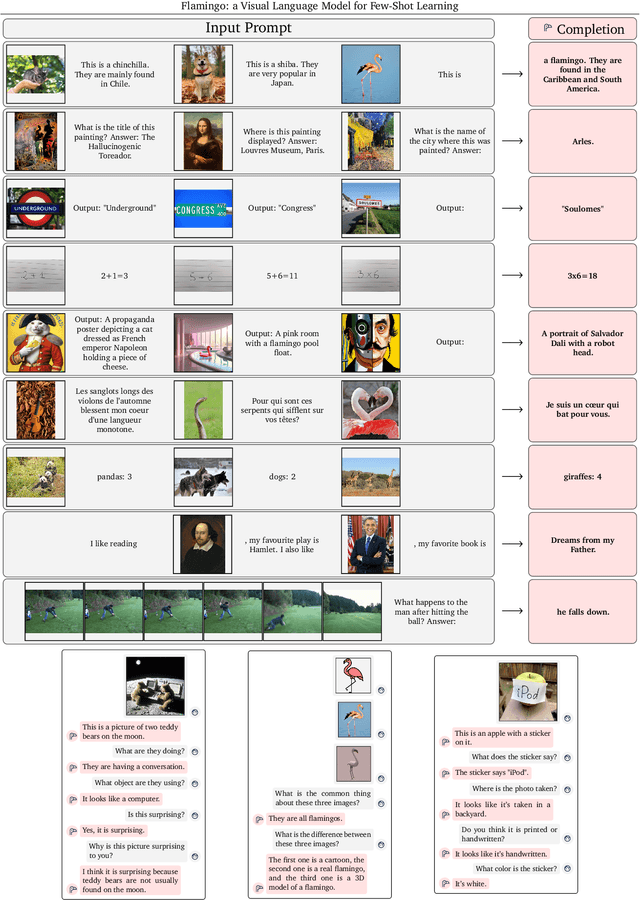

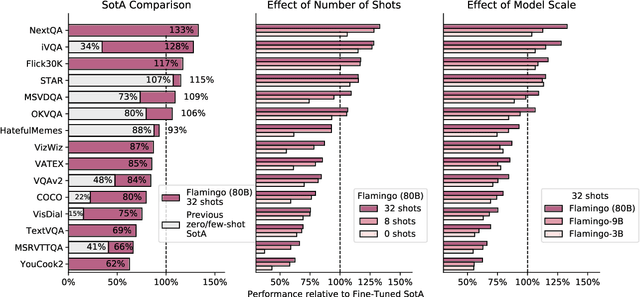
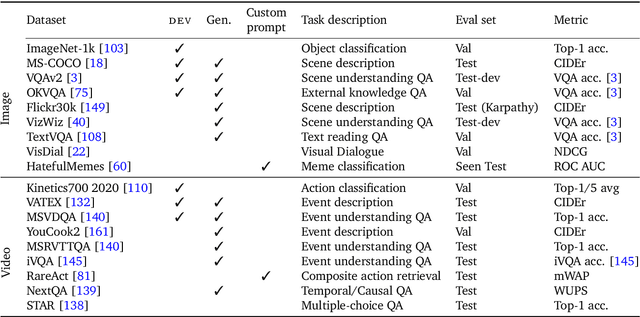
Abstract:Building models that can be rapidly adapted to numerous tasks using only a handful of annotated examples is an open challenge for multimodal machine learning research. We introduce Flamingo, a family of Visual Language Models (VLM) with this ability. Flamingo models include key architectural innovations to: (i) bridge powerful pretrained vision-only and language-only models, (ii) handle sequences of arbitrarily interleaved visual and textual data, and (iii) seamlessly ingest images or videos as inputs. Thanks to their flexibility, Flamingo models can be trained on large-scale multimodal web corpora containing arbitrarily interleaved text and images, which is key to endow them with in-context few-shot learning capabilities. We perform a thorough evaluation of the proposed Flamingo models, exploring and measuring their ability to rapidly adapt to a variety of image and video understanding benchmarks. These include open-ended tasks such as visual question-answering, where the model is prompted with a question which it has to answer, captioning tasks, which evaluate the ability to describe a scene or an event, and close-ended tasks such as multiple choice visual question-answering. For tasks lying anywhere on this spectrum, we demonstrate that a single Flamingo model can achieve a new state of the art for few-shot learning, simply by prompting the model with task-specific examples. On many of these benchmarks, Flamingo actually surpasses the performance of models that are fine-tuned on thousands of times more task-specific data.
Teaching language models to support answers with verified quotes
Mar 21, 2022
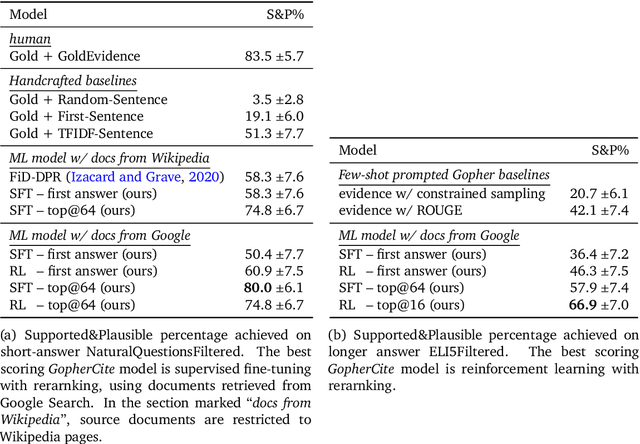


Abstract:Recent large language models often answer factual questions correctly. But users can't trust any given claim a model makes without fact-checking, because language models can hallucinate convincing nonsense. In this work we use reinforcement learning from human preferences (RLHP) to train "open-book" QA models that generate answers whilst also citing specific evidence for their claims, which aids in the appraisal of correctness. Supporting evidence is drawn from multiple documents found via a search engine, or from a single user-provided document. Our 280 billion parameter model, GopherCite, is able to produce answers with high quality supporting evidence and abstain from answering when unsure. We measure the performance of GopherCite by conducting human evaluation of answers to questions in a subset of the NaturalQuestions and ELI5 datasets. The model's response is found to be high-quality 80\% of the time on this Natural Questions subset, and 67\% of the time on the ELI5 subset. Abstaining from the third of questions for which it is most unsure improves performance to 90\% and 80\% respectively, approaching human baselines. However, analysis on the adversarial TruthfulQA dataset shows why citation is only one part of an overall strategy for safety and trustworthiness: not all claims supported by evidence are true.
Improving language models by retrieving from trillions of tokens
Jan 11, 2022



Abstract:We enhance auto-regressive language models by conditioning on document chunks retrieved from a large corpus, based on local similarity with preceding tokens. With a $2$ trillion token database, our Retrieval-Enhanced Transformer (RETRO) obtains comparable performance to GPT-3 and Jurassic-1 on the Pile, despite using 25$\times$ fewer parameters. After fine-tuning, RETRO performance translates to downstream knowledge-intensive tasks such as question answering. RETRO combines a frozen Bert retriever, a differentiable encoder and a chunked cross-attention mechanism to predict tokens based on an order of magnitude more data than what is typically consumed during training. We typically train RETRO from scratch, yet can also rapidly RETROfit pre-trained transformers with retrieval and still achieve good performance. Our work opens up new avenues for improving language models through explicit memory at unprecedented scale.
Scaling Language Models: Methods, Analysis & Insights from Training Gopher
Dec 08, 2021


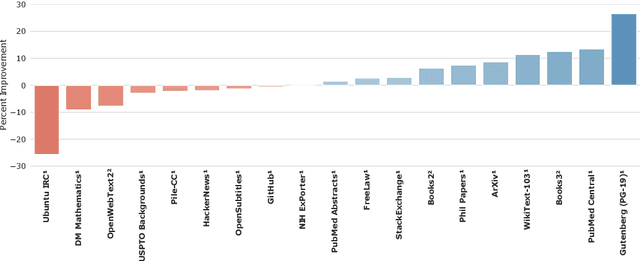
Abstract:Language modelling provides a step towards intelligent communication systems by harnessing large repositories of written human knowledge to better predict and understand the world. In this paper, we present an analysis of Transformer-based language model performance across a wide range of model scales -- from models with tens of millions of parameters up to a 280 billion parameter model called Gopher. These models are evaluated on 152 diverse tasks, achieving state-of-the-art performance across the majority. Gains from scale are largest in areas such as reading comprehension, fact-checking, and the identification of toxic language, but logical and mathematical reasoning see less benefit. We provide a holistic analysis of the training dataset and model's behaviour, covering the intersection of model scale with bias and toxicity. Finally we discuss the application of language models to AI safety and the mitigation of downstream harms.
Multimodal Few-Shot Learning with Frozen Language Models
Jul 03, 2021
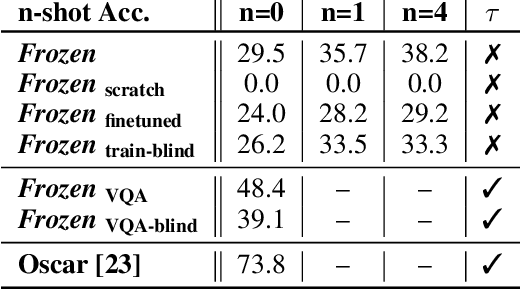
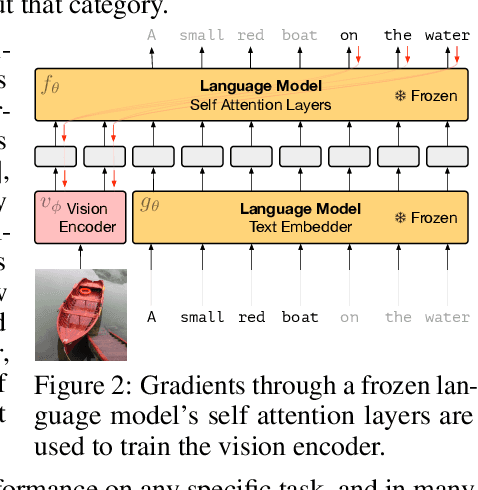
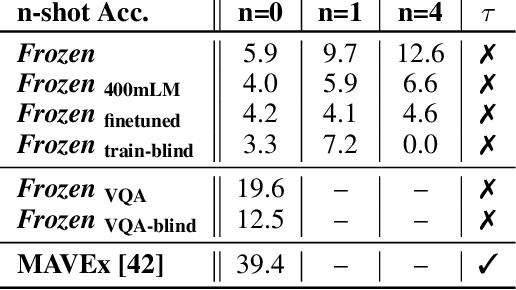
Abstract:When trained at sufficient scale, auto-regressive language models exhibit the notable ability to learn a new language task after being prompted with just a few examples. Here, we present a simple, yet effective, approach for transferring this few-shot learning ability to a multimodal setting (vision and language). Using aligned image and caption data, we train a vision encoder to represent each image as a sequence of continuous embeddings, such that a pre-trained, frozen language model prompted with this prefix generates the appropriate caption. The resulting system is a multimodal few-shot learner, with the surprising ability to learn a variety of new tasks when conditioned on examples, represented as a sequence of multiple interleaved image and text embeddings. We demonstrate that it can rapidly learn words for new objects and novel visual categories, do visual question-answering with only a handful of examples, and make use of outside knowledge, by measuring a single model on a variety of established and new benchmarks.
Generating Images with Sparse Representations
Mar 05, 2021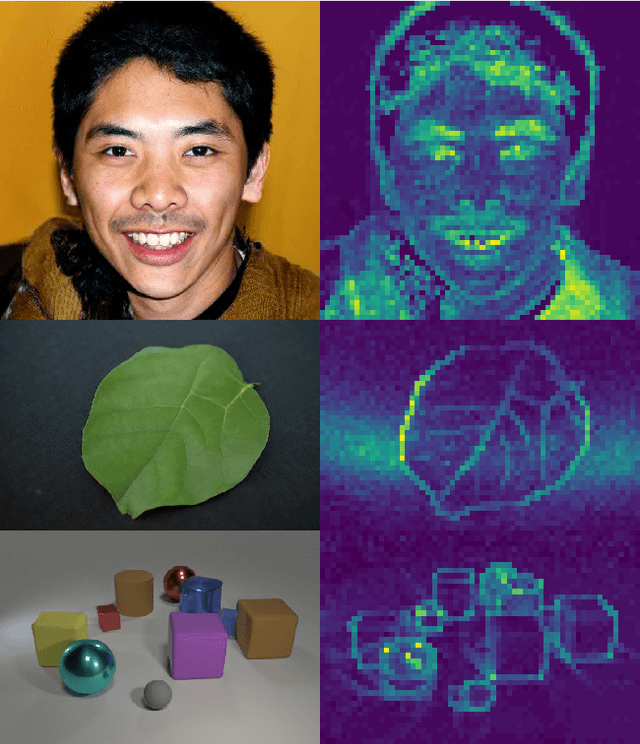
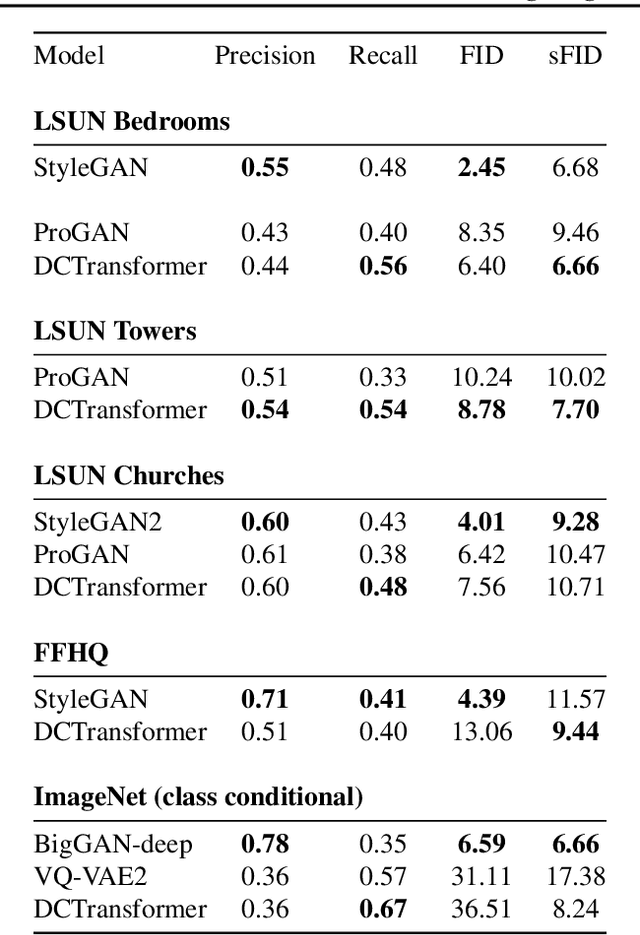
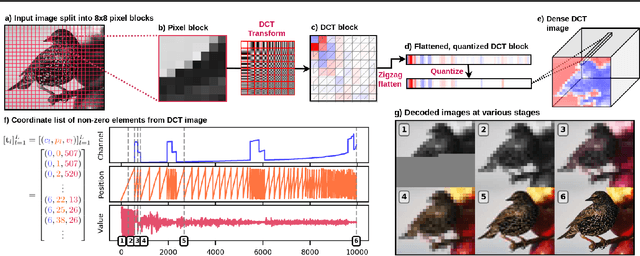
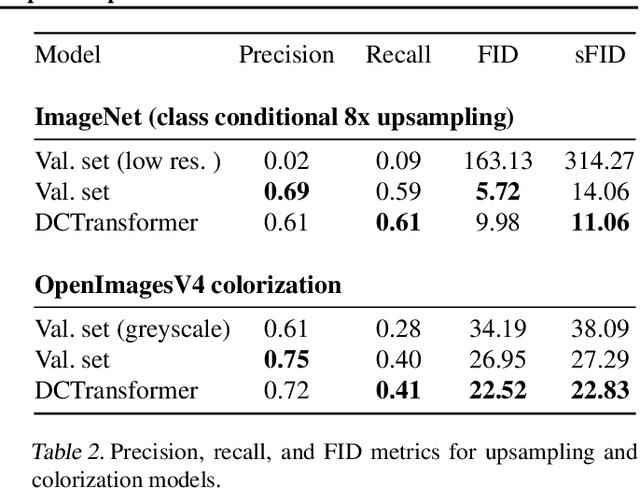
Abstract:The high dimensionality of images presents architecture and sampling-efficiency challenges for likelihood-based generative models. Previous approaches such as VQ-VAE use deep autoencoders to obtain compact representations, which are more practical as inputs for likelihood-based models. We present an alternative approach, inspired by common image compression methods like JPEG, and convert images to quantized discrete cosine transform (DCT) blocks, which are represented sparsely as a sequence of DCT channel, spatial location, and DCT coefficient triples. We propose a Transformer-based autoregressive architecture, which is trained to sequentially predict the conditional distribution of the next element in such sequences, and which scales effectively to high resolution images. On a range of image datasets, we demonstrate that our approach can generate high quality, diverse images, with sample metric scores competitive with state of the art methods. We additionally show that simple modifications to our method yield effective image colorization and super-resolution models.
A Practical Sparse Approximation for Real Time Recurrent Learning
Jun 12, 2020



Abstract:Current methods for training recurrent neural networks are based on backpropagation through time, which requires storing a complete history of network states, and prohibits updating the weights `online' (after every timestep). Real Time Recurrent Learning (RTRL) eliminates the need for history storage and allows for online weight updates, but does so at the expense of computational costs that are quartic in the state size. This renders RTRL training intractable for all but the smallest networks, even ones that are made highly sparse. We introduce the Sparse n-step Approximation (SnAp) to the RTRL influence matrix, which only keeps entries that are nonzero within n steps of the recurrent core. SnAp with n=1 is no more expensive than backpropagation, and we find that it substantially outperforms other RTRL approximations with comparable costs such as Unbiased Online Recurrent Optimization. For highly sparse networks, SnAp with n=2 remains tractable and can outperform backpropagation through time in terms of learning speed when updates are done online. SnAp becomes equivalent to RTRL when n is large.
Rigging the Lottery: Making All Tickets Winners
Nov 25, 2019



Abstract:Sparse neural networks have been shown to be more parameter and compute efficient compared to dense networks and in some cases are used to decrease wall clock inference times. There is a large body of work on training dense networks to yield sparse networks for inference. This limits the size of the largest trainable sparse model to that of the largest trainable dense model. In this paper we introduce a method to train sparse neural networks with a fixed parameter count and a fixed computational cost throughout training, without sacrificing accuracy relative to existing dense-to-sparse training methods. Our method updates the topology of the network during training by using parameter magnitudes and infrequent gradient calculations. We show that this approach requires fewer floating-point operations (FLOPs) to achieve a given level of accuracy compared to prior techniques. Importantly, by adjusting the topology it can start from any initialization - not just "lucky" ones. We demonstrate state-of-the-art sparse training results with ResNet-50, MobileNet v1 and MobileNet v2 on the ImageNet-2012 dataset, WideResNets on the CIFAR-10 dataset and RNNs on the WikiText-103 dataset. Finally, we provide some insights into why allowing the topology to change during the optimization can overcome local minima encountered when the topology remains static.
Generating High Fidelity Images with Subscale Pixel Networks and Multidimensional Upscaling
Dec 04, 2018



Abstract:The unconditional generation of high fidelity images is a longstanding benchmark for testing the performance of image decoders. Autoregressive image models have been able to generate small images unconditionally, but the extension of these methods to large images where fidelity can be more readily assessed has remained an open problem. Among the major challenges are the capacity to encode the vast previous context and the sheer difficulty of learning a distribution that preserves both global semantic coherence and exactness of detail. To address the former challenge, we propose the Subscale Pixel Network (SPN), a conditional decoder architecture that generates an image as a sequence of sub-images of equal size. The SPN compactly captures image-wide spatial dependencies and requires a fraction of the memory and the computation required by other fully autoregressive models. To address the latter challenge, we propose to use Multidimensional Upscaling to grow an image in both size and depth via intermediate stages utilising distinct SPNs. We evaluate SPNs on the unconditional generation of CelebAHQ of size 256 and of ImageNet from size 32 to 256. We achieve state-of-the-art likelihood results in multiple settings, set up new benchmark results in previously unexplored settings and are able to generate very high fidelity large scale samples on the basis of both datasets.
 Add to Chrome
Add to Chrome Add to Firefox
Add to Firefox Add to Edge
Add to Edge